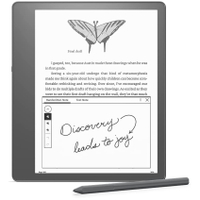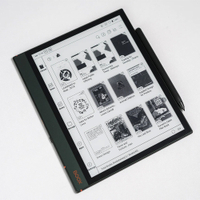TechRadar Verdict
The Kobo Elipsa 2E takes over from the 10.3-inch original Elipsa note-taking ereader that launched in 2021, with a faster response time and improved organization options. The redesigned Kobo Stylus 2 is also a better pen than the previous model, but the writing experience falls short when compared to the Amazon Kindle Scribe. What more than makes up for that – and its rather boring, albeit eco-friendly design – are the several writing tools you won’t find on Amazon’s competition, wider file format support and the third-party app integrations that make it worth the money.
Pros
- +
Faster than previous model
- +
Versatile writing tools
- +
Eco-friendly body
Cons
- -
Expensive
- -
Dated, plasticky design
- -
Sleepcover no longer bundled
Why you can trust TechRadar
Kobo Elipsa 2E: two-minute review
Like its predecessor, the Kobo Elipsa 2E lets you read, make annotations in margins, write notes, make lists, borrow from a public library that supports OverDrive and transfer files easily via Dropbox. First and foremost, though, it’s an ereader.
Physically, not a lot has changed although Kobo claims that 85% of the Elipsa 2E’s body has been made from recycled plastic, 10% of which is ocean-bound plastic. This eco-friendly approach that began with the Kobo Clara 2E is admirable, but the overall design of the Elipsa 2E hasn’t changed much and is now looking dated when compared to the likes of the Amazon Kindle Scribe and the Onyx Boox Note Air 2. I've been using a Kobo as my go-to ereader since the days of the Kobo Glo and I’m still waiting for a more premium-looking option.
That said, this 10.3-inch note-taking ereader has functionality that leaves the Kindle Scribe in the dust. Inheriting the Advanced Notebooks that first launched with the original Elipsa, there’s more page templates and pen options to choose from. Plus there’s handwriting recognition that’s almost perfect, hand-drawn diagrams that get automatically digitized, and it can even recognize superscripts. Heck, something in there will also solve mathematical equations!
The one thing that was missing in the Notebooks application on a Kobo was the ability to create subfolders, and that has now been added too. It might be the only new feature debuting with the Kobo Elipsa 2E, but if it’s a note-taking ereader you’re keen on, this is the best in my experience – and I’m comparing it to the Onyx Boox Note Air2 Plus that I also really like.
Writing on the Elipsa 2E’s screen, however, isn’t the smoothest experience – the winner here is the Kindle Scribe. There’s just a little too much friction on the screen, but the redesigned Kobo Stylus 2 is a pleasure to use, and now features an eraser on the top of the pen.
The Stylus 2 ships with the E Ink tablet but, unlike the older Elipsa, the sleepcover – which has also been redesigned for the 2E and made from 95% recycled material – is now an optional purchase. While the pen attaches magnetically to the top edge of the Elipsa 2E’s big bezel, it’s not the most secure position while traveling and the dedicated nook for it in the case (which is also magnetic, by the way) is the best option to stow the Stylus 2 away safely. The added expense makes the Elipsa 2E a slightly heftier investment compared to its predecessor if you’re after a large-screen E Ink writing tablet.
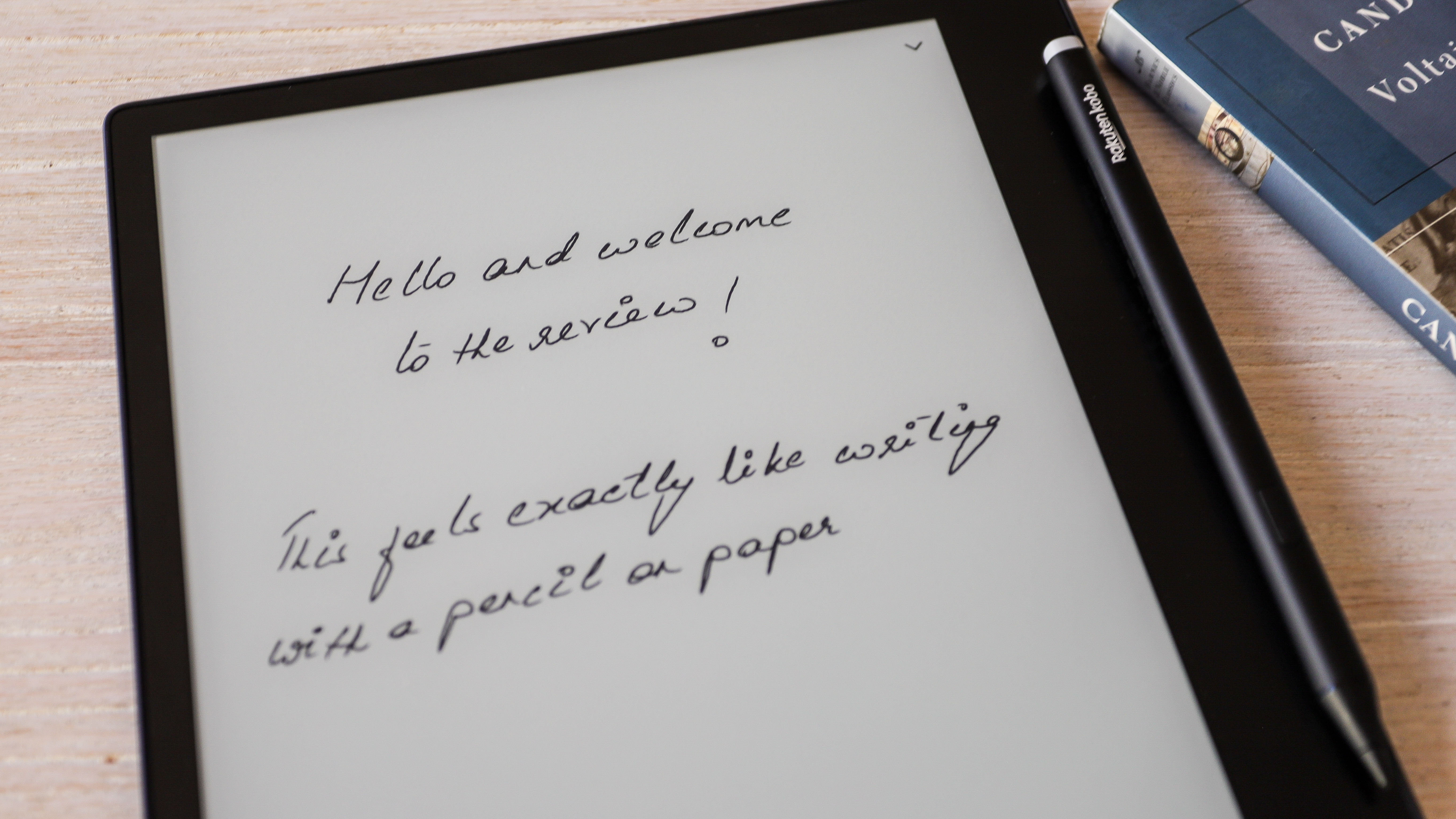
Kobo Elipsa 2E review: price & availability
- Announced April 5, 2023; shipping since April 19
- Available now from Kobo and select retailers in most markets
- Retail price of $399.99 / £349.99 / AU$629.95
The launch price of the Kobo Elipsa 2E remains the same as its predecessor’s in the US and UK, arriving with a tag of $399.99 and £349.99 respectively. It’s a different story in Australia, where the original Elipsa launched for AU$599 and the new model will now set you back AU$629.95. However, given the economic conditions, that’s no surprise, and this price does include the cost of the stylus for all customers in every market that Kobo is available in.
What is a bummer is that the Elipsa 2E will not ship with a sleepcover like the older model did. This needs to be purchased separately for $69.99 / £69.99 / AU$119.95 and you are going to need it if you want a secure spot for the Kobo Stylus 2 when transporting the Elipsa 2E.
Despite needing to buy the sleepcover separately, the Kobo Elipsa 2E is competitively priced. The Amazon Kindle Scribe with 32GB of storage (like the Kobo) and shipping with the Premium Pen but no case will cost you $390 / £380 / AU$629, a marginally cheaper option but with very limited writing tools in comparison. The reMarkable 2, on the other hand, costs $399 / £399 / $499 for the tablet alone and you’ll need to pay an extra $49 / £49 / AU$79 to get the Marker (stylus). And it’s not really an ereader, lacking frontlights.
• Value score: 4/5
Kobo Elipsa 2E: key specs
| Display type: | E Ink Carta 1200 touchscreen |
| Size: | 10.3 inches |
| Resolution: | 227ppi (1404 x 1872) |
| Processor: | 2GHz |
| Frontlight: | ComfortLight Pro |
| Storage: | 32GB |
| Battery: | 2,400mAh |
| Connectivity: | Wi-Fi, Bluetooth, USB-C |
| File support: | 15 formats |
| Size: | 193 x 227 x 7.5 mm |
| Weight: | 390g without case |
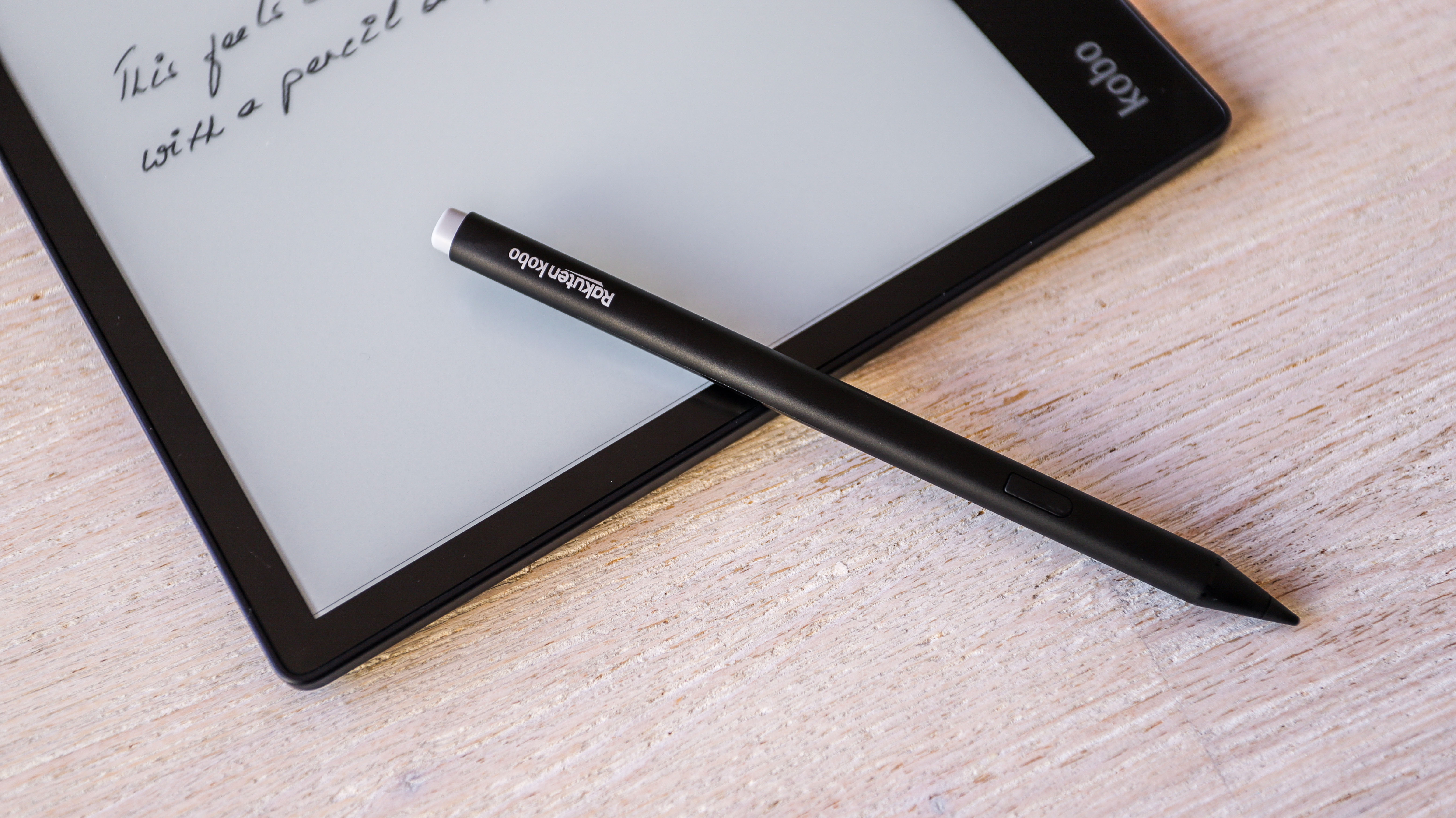
Kobo Elipsa 2E review: design & display
- Tablet and sleepcase made using recycled plastic
- Same screen tech as the original Elipsa
- Redesigned stylus much improved
It’s to Kobo’s credit that the company is using as much recycled plastic to make its latest products as possible. As mentioned earlier, the body of the Elipsa 2E is 85% recycled plastic, including some that would have ended up in our oceans. Kobo isn’t alone in doing this – the Amazon Kindle Scribe’s body is 100% recycled aluminum and 48% recycled plastic.
Look at both competitors side by side and you’ll find that the Kindle Scribe just oozes oomph with that metal body while the Elipsa 2E feels a little lackluster with its all-plastic chassis. That plastic body makes the Elipsa lighter than the Kindle Scribe (390g vs 433g) and, even with its sleepcover on, I found the Kobo a bit more comfortable to hold while reading in bed or on the couch compared to the Amazon counterpart. Unlike the Kindle, however, the Elipsa 2E doesn’t have uniform thickness all round – it tapers down from the big bezel towards a thinner edge that fits into the sleepcover designed specifically for this model.
Despite the lackluster design, I like the textured rear panel of the Kobo, which offers good grip, and the power/sleep button on the side of the device is similarly textured, making it very tactile and easy to find without looking for it. That said, I found using that button now takes a little more elbow grease than it has on any other Kobo device I’ve tested before.
Below the power/sleep button is the USB-C charging port, with a tiny battery-charging indicator light in between. The only other design element on the device is a pair of knobby ‘feet’ on the rear.
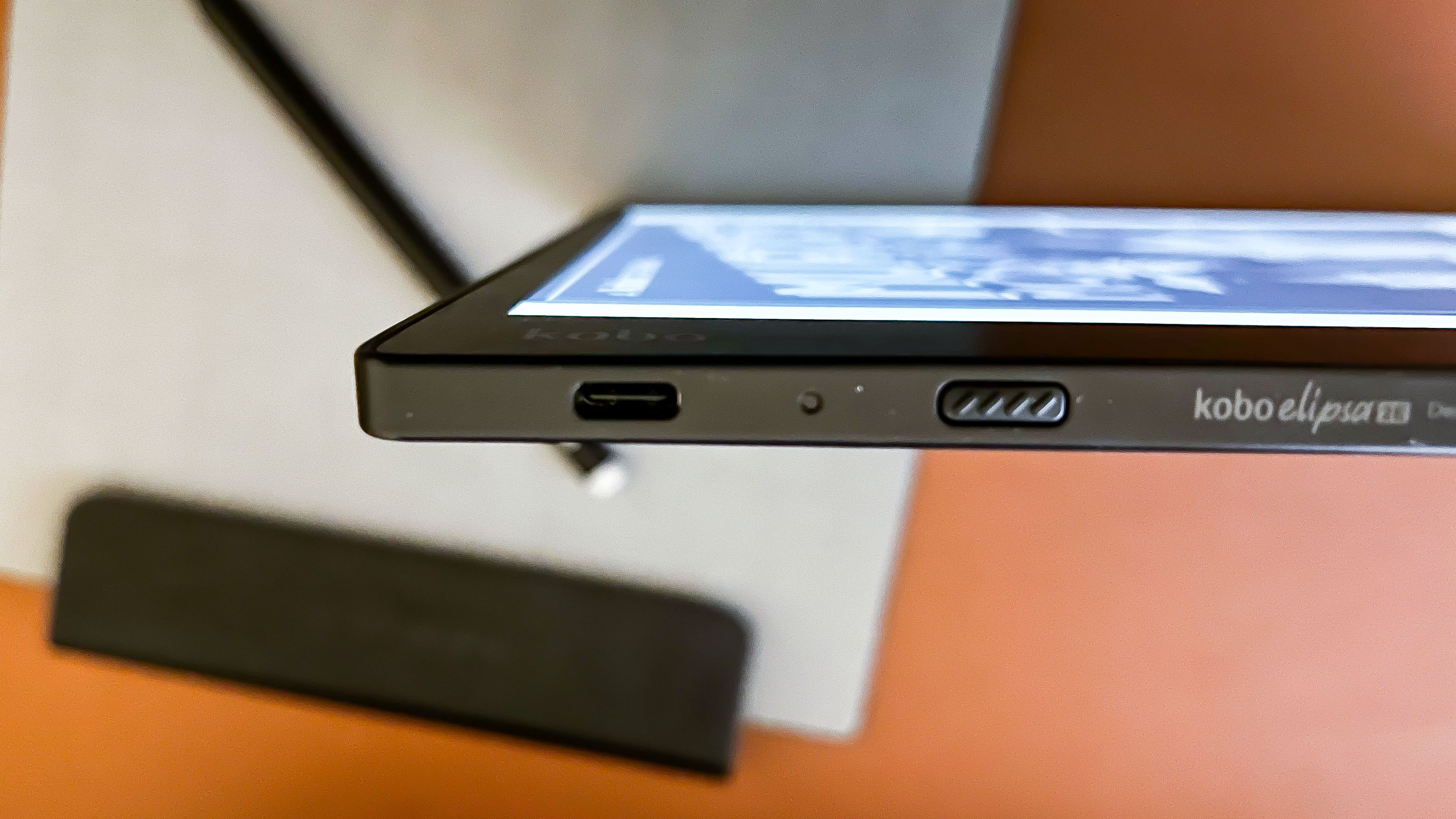
The display on the Elipsa 2E is the same as was used in the older model, so it’s an E Ink Carta 1200 screen with a resolution of 227ppi. In comparison, again the Scribe outshines its competition with a 300ppi resolution on the same screen tech – Amazon’s managed to make it appear brighter (and I don’t mean because of the frontlight) and sharper. The lower resolution of the Elipsa 2E, however, doesn’t affect how everything is displayed on screen – everything is perfectly clear and rendered well.
One improvement the Elipsa 2E has over its predecessor is the addition of amber LEDs that now allow both the brightness and the light temperature (or hue) to be adjusted like on the Kobo Libra 2 and other more portable models. The dark mode that the Carta 1200 screens support is also available here.
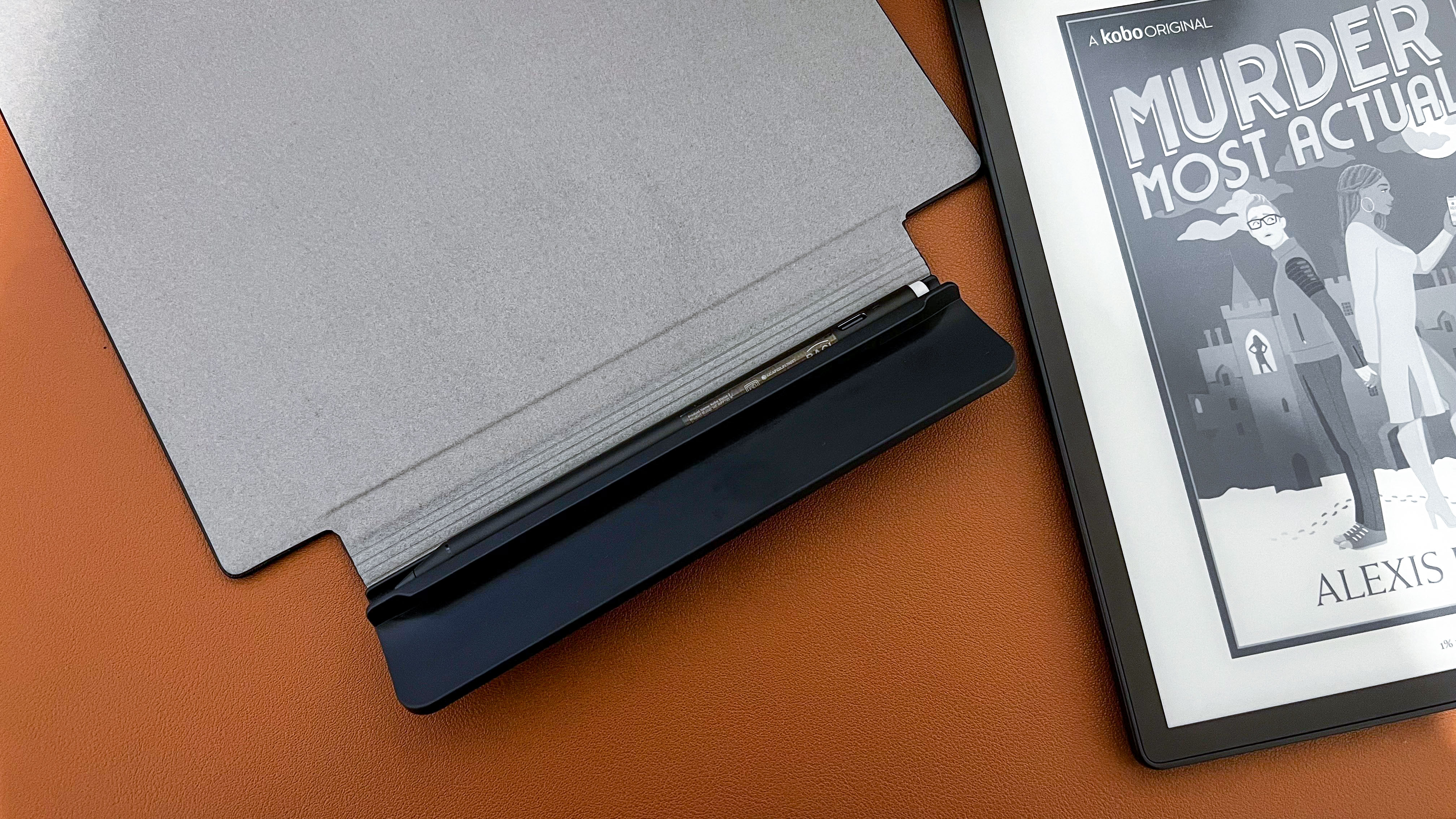
What does get a full redesign though is the stylus that ships with the Elipsa 2E. The Kobo Stylus 2, like its predecessor, is an aluminum pen but it now boasts a white ‘eraser’ at the top. This little splash of color adds a bit of contrast to what is otherwise an all-black stylus. However, running the plastic eraser across a screen that has some friction to it has made me wondering whether it will scratch the display in the long run. I haven’t seen any indication of that so far, but it might be something to keep in mind.
Where the older pen had two buttons close to the nib – one to erase and the other to highlight sections in a book or document – the Kobo Stylus 2 has just the one button now to use as the highlighter. The new pen is also slimmer as it no longer needs to fit a AAA battery to power it – it can be recharged via the USB-C port placed just below the eraser – and this makes it lighter too.
Despite being an optional extra, it would be remiss of me to not briefly describe the new sleepcover Kobo has made for the Elipsa 2E. Unlike other ereader cases that have two ‘leaves’ for the front and back, the Elipsa 2E’s slipcase is a single faux leather sheet that only covers the tablet’s screen. Attached to its spine is a magnetized ‘shelf’ that the Elipsa 2E just sticks onto (and quite strongly I should add) along with a narrow space (also magnetized) for the Kobo Stylus 2. I really like this new cover but, unlike the one that ships with the older Elipsa, it’s not foldable and you can’t use it as a stand. In keeping with the planet-friendly theme, Kobo claims that 95% of the material used to make the sleepcover is recycled.
• Design score: 3.5/5

Kobo Elipsa 2E review: features
- Versatile, advanced writing tools
- 32GB internal storage
- Upgraded CPU
The Elipsa 2E might not offer anything different from what we’ve already seen in its predecessor, but Kobo has upped the ante a little where it counts – speed. The second-generation model now boasts a faster processor (2GHz) as compared to the 2021 Elipsa (1.8GHz) and that’s made a lot of difference in how quickly the tablet responds to taps, gestures and the pen.
Another minor change, but a very welcome one, is the ability to create folders and subfolders for your notes in the My Notebooks app. This simple organizational tool was missing in the Elipsa and the Kobo Sage and was one of my few disappointments with what has always been my favorite ereader/digital note-taker user interface.
Other than that, it’s all pretty much the same as before. You get 32GB of internal storage (not expandable) – which is a massive amount for ebooks and notes but can soon fill up if you primarily prefer audiobooks – along with Bluetooth connectivity that gives you the ability to listen to said audiobooks (but only those purchased on the Kobo Store) via wireless headphones or speakers, and a 2,400mAh battery that charges via a USB-C port.
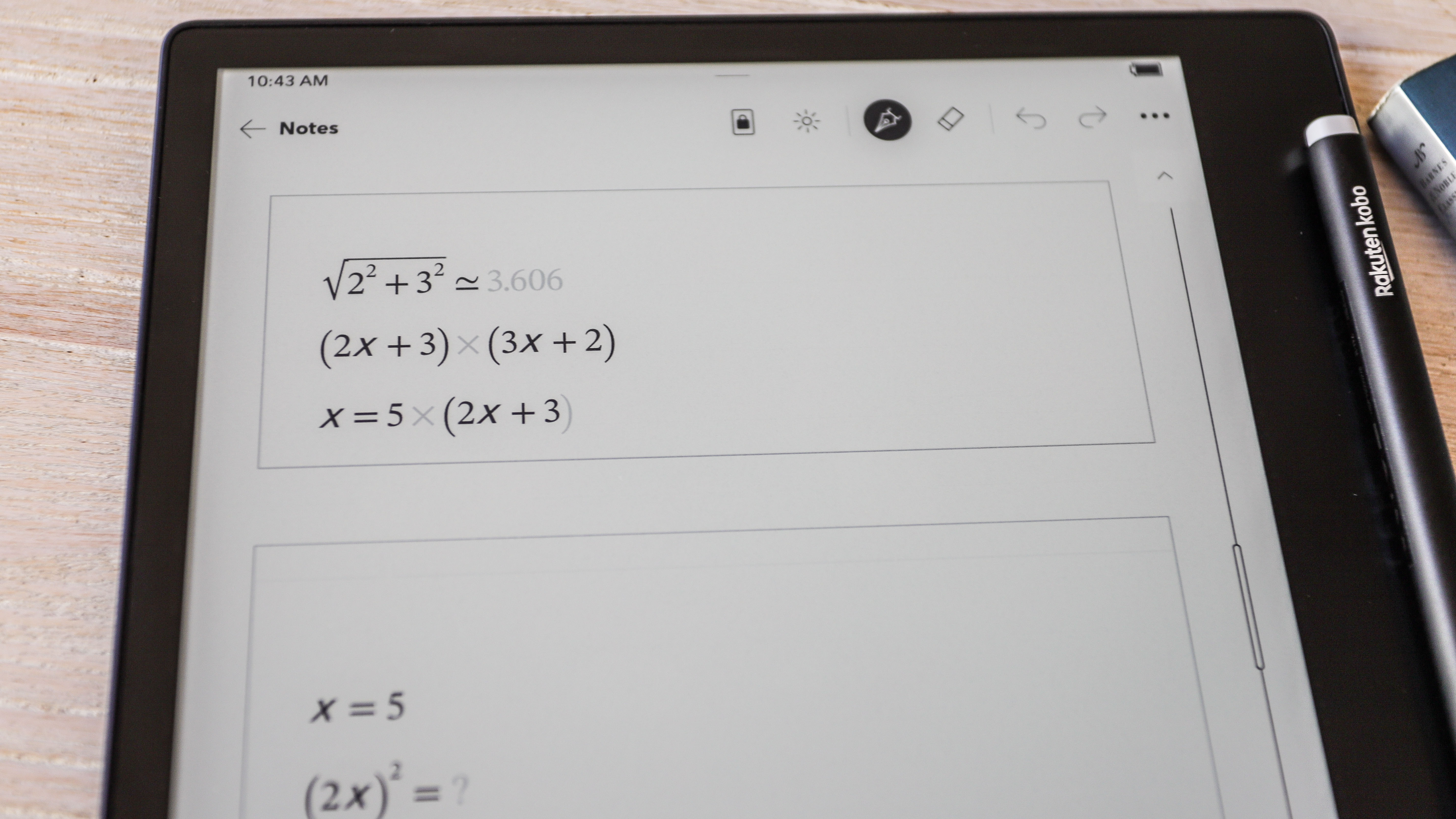
All the other reasons Kobo has long been my go-to ereader brand over a Kindle have made their way over. There’s extensive file support, with 15 native formats supported for ebooks and documents and one for audio which is restricted to Kobo’s audiobook format. Kobo has always made it easy to sideload your existing ebook collection onto its devices and that remains true here, but you cannot save handwritten annotations to these – sideloaded ebooks are restricted to typed annotations only but you can always scribble on the page. Handwritten annotations on Kobo EPUBs (the file format of all ebooks on the Kobo Store) can, however, be saved.
The font support is extensive too, with 12 supported in up to 50 styles and you can sideload any other font you prefer, including Amazon’s own like Bookerly or Ember. Considering the slightly lower screen resolution, it’s good to know you can add more ‘weight’ to the copy, meaning you can make it a little bolder, but getting to that option is not intuitive and requires you to go into the Advanced font settings while you’re reading an ebook (it’s easily available on the Kindle’s font settings however).
Despite OverDrive being retired as a mobile application for borrowing library books, it remains on the Kobo ereaders and will be supported at least for the time being. To use this feature you just need to be a member of a library that has OverDrive support, then follow the on-screen instructions on the Kobo to set it up. You can even annotate borrowed books, but note that you lose those annotations when the book is returned.
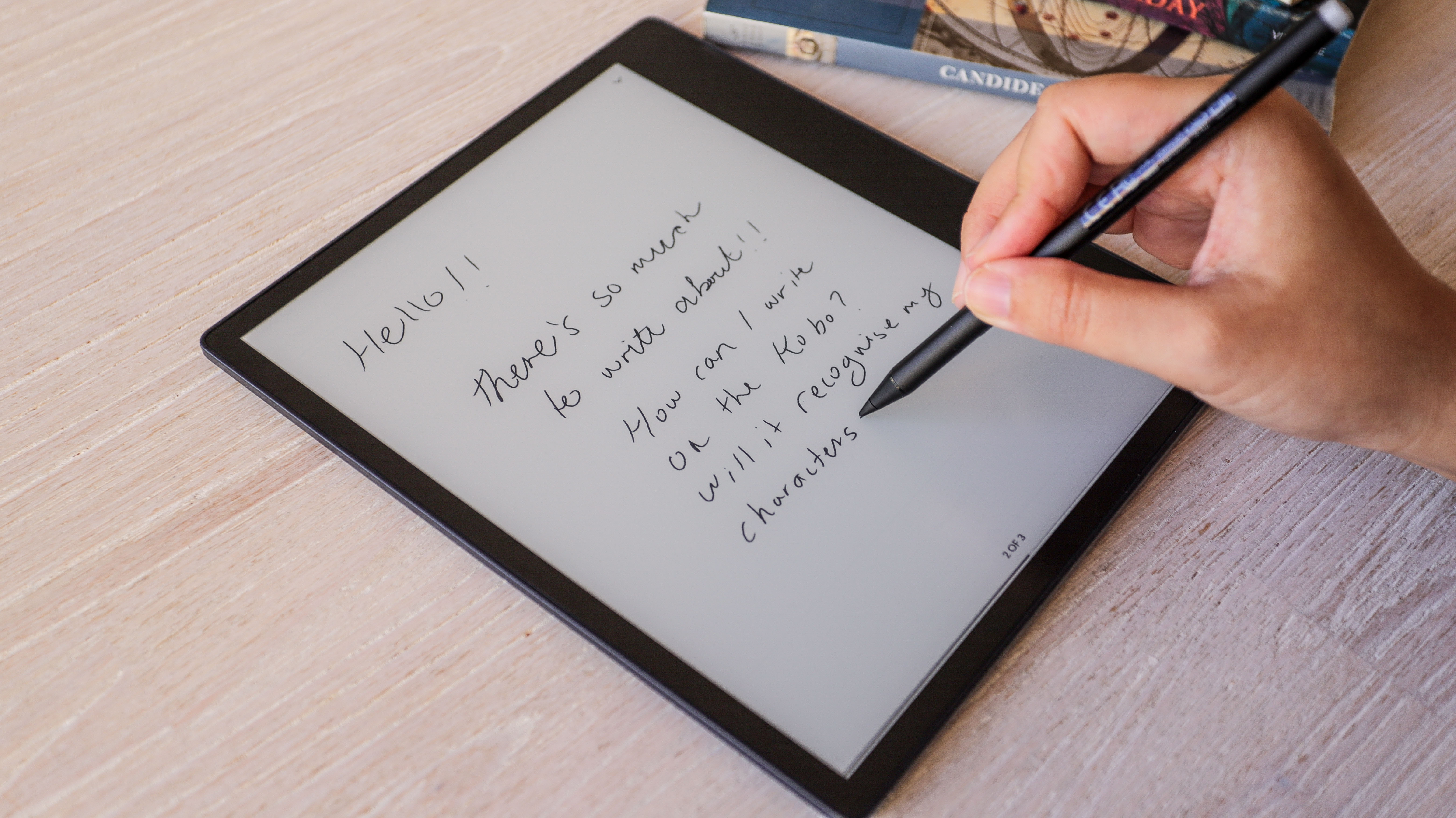
Pocket and Dropbox support is also available here. The former is essentially a web browser plugin that lets you save longform online articles to read later and, if you sign into your Pocket account on the Elipsa 2E, they’ll all be available to you on the device. The latter, of course, will give you an easy way to transfer files if you have a Dropbox account. No installation is needed for any of these third-party apps, you just need to sign into an existing account.
Where Kobo’s note-taking ereaders really shine is in the writing tools you have at your disposal. I’ve already waxed lyrical on how much more value the Elipsa 2E offers over the Kindle Scribe when it comes to writing, particularly since all your scribbles can be digitized and saved as text. And how often can you say your ereader solved a mathematical equation for you? I should stress, however, that notes are not available in the Kobo mobile app (if you use that in tandem to read) as the My Notebooks tab has been designed only for Kobo’s hardware. This is something I’m hoping the company can rectify in the future.
The only feature I missed is a battery level indicator for the Stylus 2. While you can see a status of the pen’s battery life when the tablet itself is plugged in for a top up – you need to tap on the battery icon for it to be displayed – there’s no other indication of the pen’s battery level. Kobo hasn’t revealed the Stylus 2’s battery capacity and I didn’t have the device with me long enough during my testing to see how far it can go before it needs a charge.
• Feature score: 4.5/5
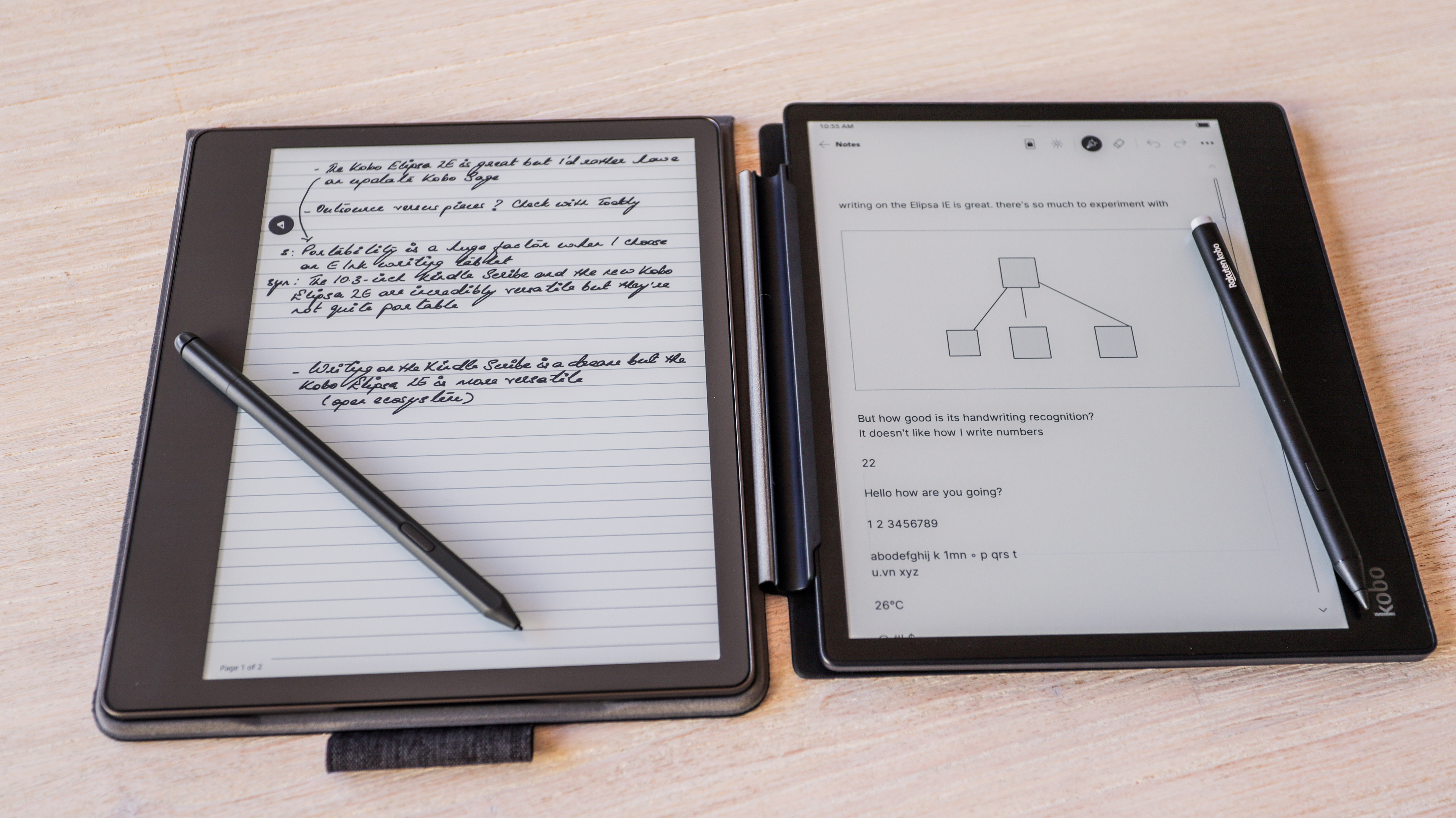
Kobo Elipsa 2E review: performance
- Faster and more responsive than original Elipsa
- Excellent handwriting recognition
- Average battery life; disappointing compared to the Kindle Scribe
Giving the Elipsa 2E a better CPU has paid off – it’s now faster and more responsive than its predecessor. This is particularly noticeable when typing using the on-screen keyboard. For example, my experience with typing on the Sage and the Elipsa had taught me to take it slow, waiting for each letter or number to appear in the text box before tapping the next. And if I happened to speed up on a word with double letters (like typing the word ‘letter’), I invariably found it spelt with one of them missing (like ‘leter’). That issue is no longer a problem and it was a pleasure to be able to type at my usual speed on the Elipsa 2E.
Where it is a little slow is in the page refresh after the eraser has been used. Here, the Kindle Scribe is faster, with a refresh getting triggered almost immediately. The Elipsa 2E takes a split second longer for the refresh to be triggered, so the ghosting (remnants or artifacts of the previous page or writing) is a little more evident on the Kobo in comparison.
Writing on the Elipsa 2E is also a good experience with everything appearing in real time on the screen. I am still very partial to how smooth it feels when writing on the Kindle Scribe, but some of my colleagues actually prefer the little friction the Kobo’s screen offers. That friction, however, has seemingly caused some wear and tear on the Stylus 2’s nib which initially felt like a pencil on paper but smoothened out a little after further use.
The writing experience is complimented very nicely by Kobo’s excellent handwriting recognition capabilities. It harnesses the tech developed by MyScript and the Nebo app, and can accurately identify (and convert) some really bad handwriting. Three of us on the TechRadar team did our best to throw our worst scribbles at the Elipsa 2E and, surprisingly, it would get at least 98% of that correct, including recognizing symbols and superscripts (like degrees of temperature, for example).
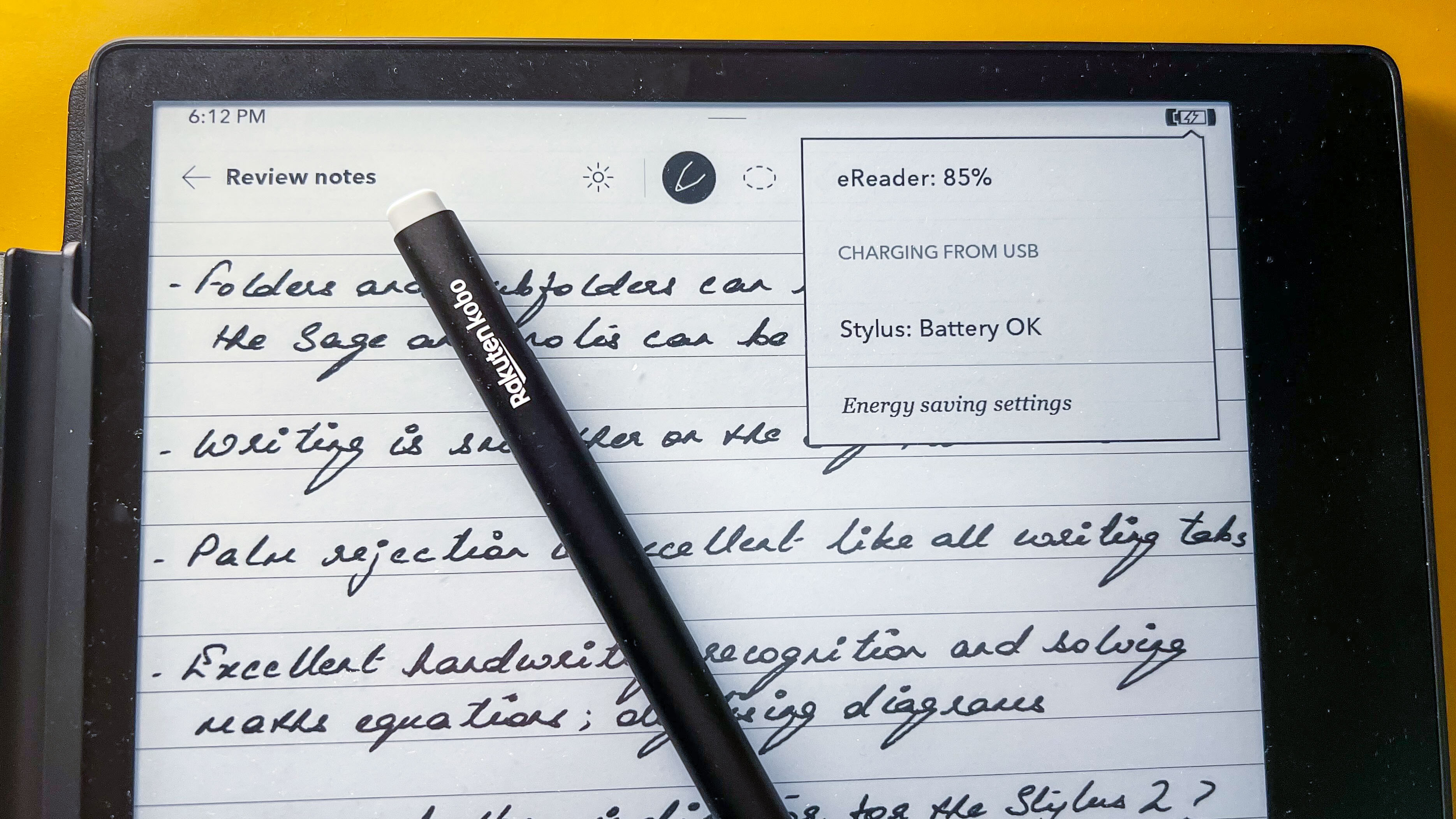
It goes without saying that the reading experience on the Elipsa 2E is also excellent. As I’ve already mentioned, I prefer the Kobo reading UX over the Kindle despite the differences being minor.
Where the Kindle Scribe leaves the Elipsa 2E far in the dust is in battery life. I am a little disappointed that Kobo has chosen to stick with the same 2,400mAh capacity pack when Amazon gave the Kindle Scribe a 3,000mAh battery.
To put the Elipsa 2E’s battery performance into more precise numbers, I got 31.5 hours of use (includes lots of reading and writing, with some audiobook listening and browsing the Kobo Store) with the battery going from 100% down to 15%. Meaning you can get about four to five weeks (maybe a little more depending on use) per charge, which matches our testing of the 2021 Elipsa, but the Kindle Scribe can give you double that with very extensive use.
Plugged into a wall charger with a 12W USB-A port, the Elipsa 2E took about 2 hours and 10 minutes to fully charge up from 14%. During my testing I unfortunately couldn’t find a USB-C to C cable to use with the 25W USB-C port on my wall charger, but I expect that would be a bit quicker to top up.
• Performance score: 4.5/5
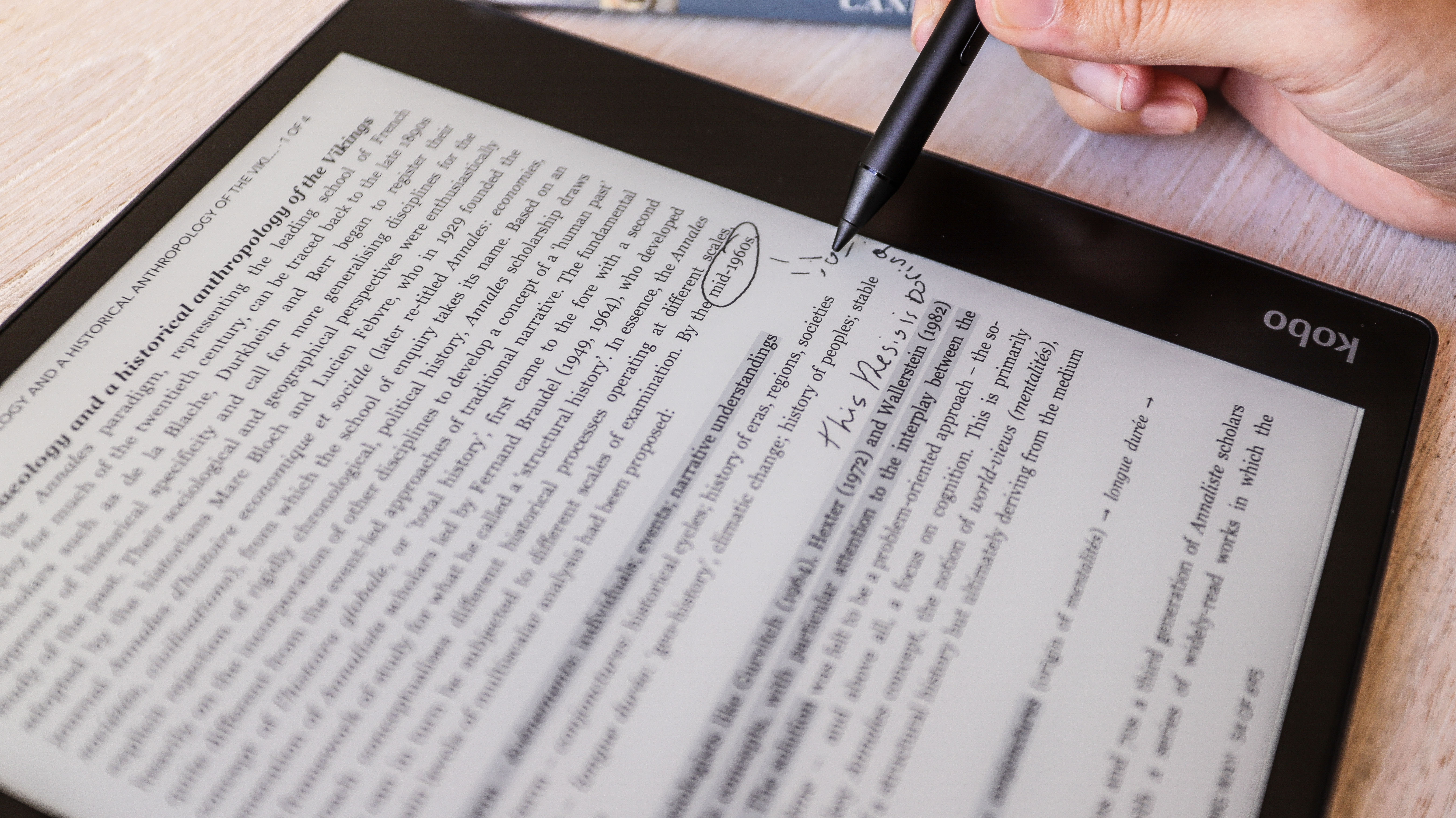
Should I buy the Kobo Elipsa 2E?
| Section | Notes | Score |
|---|---|---|
| Value | It is an expensive ereader but it’s worth it if you will make full use of its writing capabilities. | 4/5 |
| Design | It’s a very familiar design and falls short when compared to some of the competition, but it’s sturdily built and does its bit for the planet. | 3.5/5 |
| Features | It doesn’t do too much that’s different but it sure offers more versatility as a note-taking device compared to the Kindle Scribe. | 4.5/5 |
| Performance | By virtue of its better CPU, which has made it faster, we have to score the Elipsa 2E higher than its predecessor here. | 4.5/5 |
Buy it if...
You’re an avid writer/note-taker and reader
While the reMarkable 2 might be the more capable E Ink note-taker, the Elipsa 2E is a lot more versatile – it offers better reading features than the reMarkable and far superior writing tools than the Kindle Scribe.
You want a large-screen ereader
A 10.3-inch ereader is great for anyone who loves comics and graphic novels. Moreover, marking up PDFs on a big screen like this is great too. And considering the Elipsa 2E is actually well balanced, you can use it to read for long periods of time without your arm complaining too much.
Don't buy it if...
You want to do more than just read and write on a tablet
If you’re not going to spend much time reading or writing on an E Ink tablet, but want something to watch videos on as well as multitask with other apps, you’re going to need something much more powerful, like an iPad or a Samsung tablet.
You want a portable ereader
While the Elipsa 2E will go into a backpack or messenger bag, it’s not what I’d call ‘portable’. If the time you spend reading is on your daily commute, then you might want to consider a smaller ereader like the 7-inch Kobo Libra 2 or the Amazon Kindle Paperwhite. The 8-inch Kobo Sage also offers writing capabilities, but the stylus needs to be purchased separately.
Also consider
Not sold on the Kobo Elipsa 2E? Take a look at the specs and description of a couple of competitors below and decide for yourself.
| Kobo Elipsa 2E | Amazon Kindle Scribe | Onyx Boox Notes Air2 Plus | |
|---|---|---|---|
| Price | $399.99 / £349.99 / AU$629.95 | from $339.99 / £339.99 / AU$549.99 | $499.99 / €519.99 / AU$779 |
| Screen | 10.3-inch E Ink Carta 1200 | 10.2-inch E Ink Carta 1200 | 10.3-inch E Ink Carta 1200 |
| Resolution | 227ppi | 300ppi | 227ppi |
| Operating system | Linux-based | Linux-based | Android 11 |
| Storage | 32GB | 16GB, 32GB, 64GB | 64GB |
| CPU | Quad-core, 2GHz | 1GHz MediaTek MT8113 | Octa-core, 2GHz |
| Battery capacity | 2,400mAh | 3,000mAh | 3,700mAh |
| Connectivity | Wi-Fi, Bluetooth, USB-C | Wi-Fi, Bluetooth, USB-C | Wi-Fi, Bluetooth, USB-C |
| Waterproofing | No | No | No |
| File support (including audio) | 16 | 14 | 22 |
| Dimensions | 193 x 227 x 7.5 mm | 196 x 230 x 5.8mm | 229.4 × 195.4 × 5.8 mm |
| Weight | 390g | 433g | 445g |
Amazon Kindle Scribe
The direct competition from Amazon looks great thanks to its metal body and has a great-looking screen. Writing on it is a pleasure, at least it is for me. While it makes an excellent large-screen ereader – especially now that you can upload EPUBs to it via the Send To Kindle app – it falls short when it comes to writing tools.
Read our full Amazon Kindle Scribe review
Onyx Boox Note Air2 Plus
If you want an E Ink tablet that can also give you a browser and a music player built-in, this is it. In fact, thanks to its Android 11 operating system, you get access to most of what’s available on the Google Play Store, so you can always read on the Kindle or Kobo app on this device. Its writing tools are quite extensive too and its 3,700mAh battery goes on forever. Getting your head around its interface, though, can take a little while.
Read more about the Onyx Boox Note Air2 Plus
How I tested the Kobo Elipsa 2E
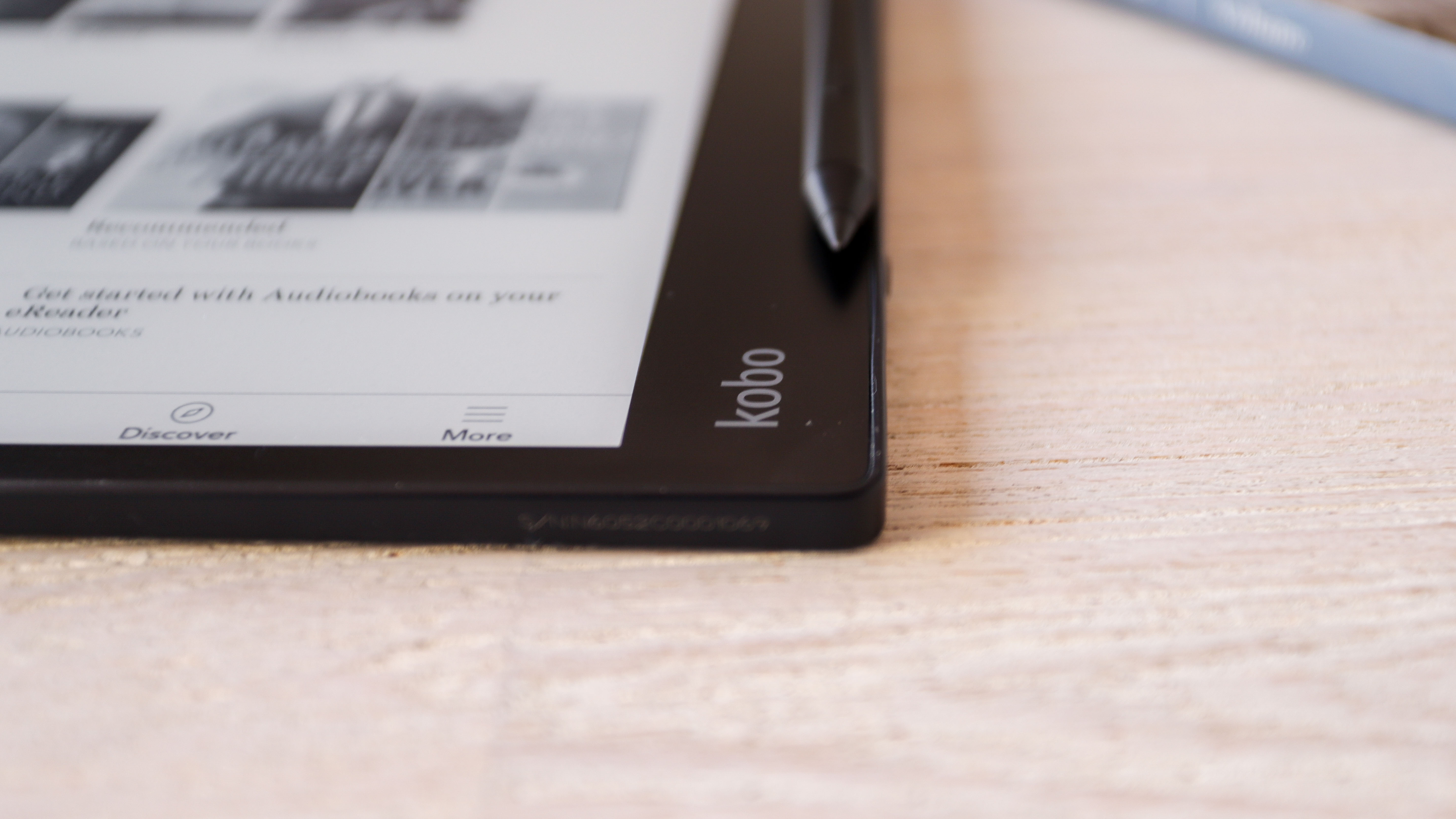
- Tested for three weeks which included a new firmware update being rolled out
- Used it extensively for reading and as a writing tablet
- Used at home for nighttime reading, during work for note-taking and, occasionally, to listen to audiobooks
While I was sent the Kobo Elipsa 2E ahead of its launch, I wanted until it was officially announced to make sure I had the correct firmware before I began testing it fully. I’ve spent a total of three weeks (two since its announcement) using it as an ereader and a note-taker for the most part.
I am also in possession of a Kindle Scribe and the Onyx Boox Note Air2 Plus, which gave me a couple of options to compare the device with, and I also had the 13.3-inch Onyx Boox Tab X too to see how it compares to an even larger E Ink screen.
The Elipsa 2E came preloaded with a bunch of books, but I also sideloaded a couple of EPUBs from my own collection to test handwritten annotations on them. The device also gave me access to Kobo Plus (the Australian library where the tablet was tested for this review), so I downloaded a few extra titles to read. I used the preloaded audiobooks to listen to.
During my time with the Elipsa 2E, I used it to jot down anything work-related, from my todo list to all notes and reminders. These I have converted to text and exported to my PC.
[First reviewed April 2023]

While she's happiest with a camera in her hand, Sharmishta's main priority is being TechRadar's APAC Managing Editor, looking after the day-to-day functioning of the Australian, New Zealand and Singapore editions of the site, steering everything from news and reviews to ecommerce content like deals and coupon codes. While she loves reviewing cameras and lenses when she can, she's also an avid reader and has become quite the expert on ereaders and E Ink writing tablets, having appeared on Singaporean radio to talk about these underrated devices. Other than her duties at TechRadar, she's also the Managing Editor of the Australian edition of Digital Camera World, and writes for Tom's Guide and T3.

